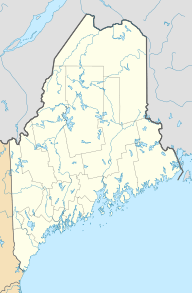Millinocket Lake (Aroostook River) facts for kids
Quick facts for kids Millinocket Lake |
|
|---|---|
| Location | Piscataquis County, Maine |
| Coordinates | 46°18′N 68°52′W / 46.300°N 68.867°W |
| Primary inflows | Chandler Brook Moose Brook |
| Primary outflows | Millinocket Stream |
| Basin countries | United States |
| Max. length | 6 mi (9.7 km) |
| Max. width | 1 mi (1.6 km) |
| Surface area | 2,730 acres (1,100 ha) |
| Max. depth | 54 feet (16 m) |
| Water volume | 852 acre⋅ft (1,051,000 m3) |
| Surface elevation | 755 ft (230 m) |
Millinocket Lake is a beautiful lake located in the North Maine Woods, which is a large forest area north of Baxter State Park. This lake is very important because it is the starting point for the Millinocket Stream.
The Millinocket Stream flows for about 5.5 miles (8.9 km) until it meets Munsungan Stream. Together, they form the Aroostook River, which is a major river in Maine.
Contents
About Millinocket Lake
Millinocket Lake is quite long, stretching about 6 miles (9.7 km). It is also about 1 mile (1.6 km) wide. The lake covers a large area of about 2,730 acres.
How the Lake Was Formed
A wooden dam was built on Millinocket Lake. This dam made the lake much bigger than it used to be. It caused the water to flood nearby areas, including what were once Little Millinocket Lake and Moose Pond.
The main reason for building this dam was to store water for making electricity. This process is called hydropower.
Animals and Plants in the Lake
The areas that were flooded by the dam created shallow, wet lands called bogs. These bogs are excellent homes for certain types of fish. You can find fish like fallfish, yellow perch, and white suckers living here.
However, the water temperature in the lake changes a lot in summer. Near the surface, it can be around 70°F (21°C). Even in deeper parts, it can be about 55°F (13°C). Because of these temperatures, there isn't enough oxygen dissolved in the water for fish like trout to live comfortably.
Other Ponds Nearby
Many smaller ponds and streams flow into Millinocket Lake. These are called tributaries. Some of these ponds include Atkins Pond, Blackmore Pond, Buckley Pond, and Big Caribou Pond. There are also Little Caribou Pond, Chandler Pond, Elsie Pond, and Ervin Pond. Other ponds that feed into the lake are Jack Pond, Kyle Pond, Line Pond, Mathews Pond, May Pond, Little Moose Pond, Upper Moose Pond, Pretty Pond, Snowshoe Pond, and Spring Pond.



